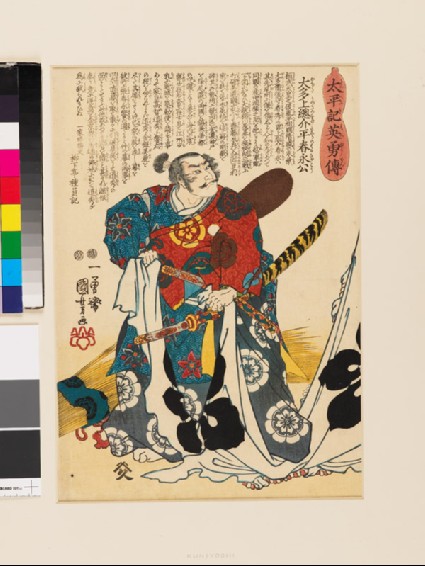Browse: 10610 objects
- Reference URL
Actions
The warrior Harunaga-kō tearing a tent bearing his vassal's crest
-
Details
- Series
- Tales of Heroes of the Chronicles of the Great Peace
- Associated place
- Date
- 1847 - 1850
- Artist/maker
-
Utagawa Kuniyoshi (1797 - 1861) (designer)Ryūkatei Tanekazu (1804 - 1858) (author)
- Associated people
-
Yamamotoya Heikichi (active early 19th century - 1886) (publisher)Oda Nobunaga (1834 - 1582) (subject)Akechi Mitsuhide (c. 1528 - 1582) (heraldry on object)Murata Heiemon (active 1843 - 1853) (censor)Mera Ta’ichirō (active c. 1848 - 1853) (censor)
- Material and technique
- woodblock
- Dimensions
-
mount 55.6 x 40.4 cm (height x width)
sheet 36.9 x 25.9 cm (height x width)
- Material index
- Technique index
- Object type index
- No. of items
- 1
- Credit line
- Presented by George Grigs, Miss Elizabeth Grigs, and Miss Susan Messer, in memory of Derick Grigs, 1971.
- Accession no.
- EA1971.103
-
Further reading
Impey, Oliver, and Mitsuko Watanabe, Kuniyoshi's Heroes of China and Japan: A Selection of Warriors from Two Series of Prints and a Painting by Utagawa Kuniyoshi (1798 - 1861), the Suikoden of 1827 and the Taiheki of 1848-9 (Oxford: Ashmolean Museum, 2003), no. 11 on p. 11, illus. p. 23 pl. 11
Location
-
- currently in research collection
Objects are sometimes moved to a different location. Our object location data is usually updated on a monthly basis. Contact the Jameel Study Centre if you are planning to visit the museum to see a particular object on display, or would like to arrange an appointment to see an object in our reserve collections.
Publications online
-

Kuniyoshi’s Heroes of China and Japan
Oda Nobunaga, 1534-1582, (here disguised under the name of Harunaga-kō) was a descendant of Taira no Kiyomori. He was the first of the three great unifiers of Japan at the end of the civil wars of the Sengoku-jidai, 1467-1568, defeating many key figures during the period and conquering several domains. In 1582 he ordered Akechi Mitsuhide, 1528?-1582, (here Takechi Michihide), one of his vassals, to provide entertainment for a great welcoming party for Tokugawa leyasu (1542-1616). Mitsuhide organised it most sumptuously, displaying treasures of gold and silver; however, Nobunaga became very angry when Mitsuhide used a tent curtain marked with his own crest.
In this print 'Harunaga-kō' is in court robes, wearing a tachi sword, tearing the tent curtain containing 'Takechi's' crest, in anger. Mitsuhide later turned against Nobunaga, who he caused to commit suicide at the Honnō-ji incident of the same year, when he burned down Azuchi castle.
© 2013 University of Oxford - Ashmolean Museum

